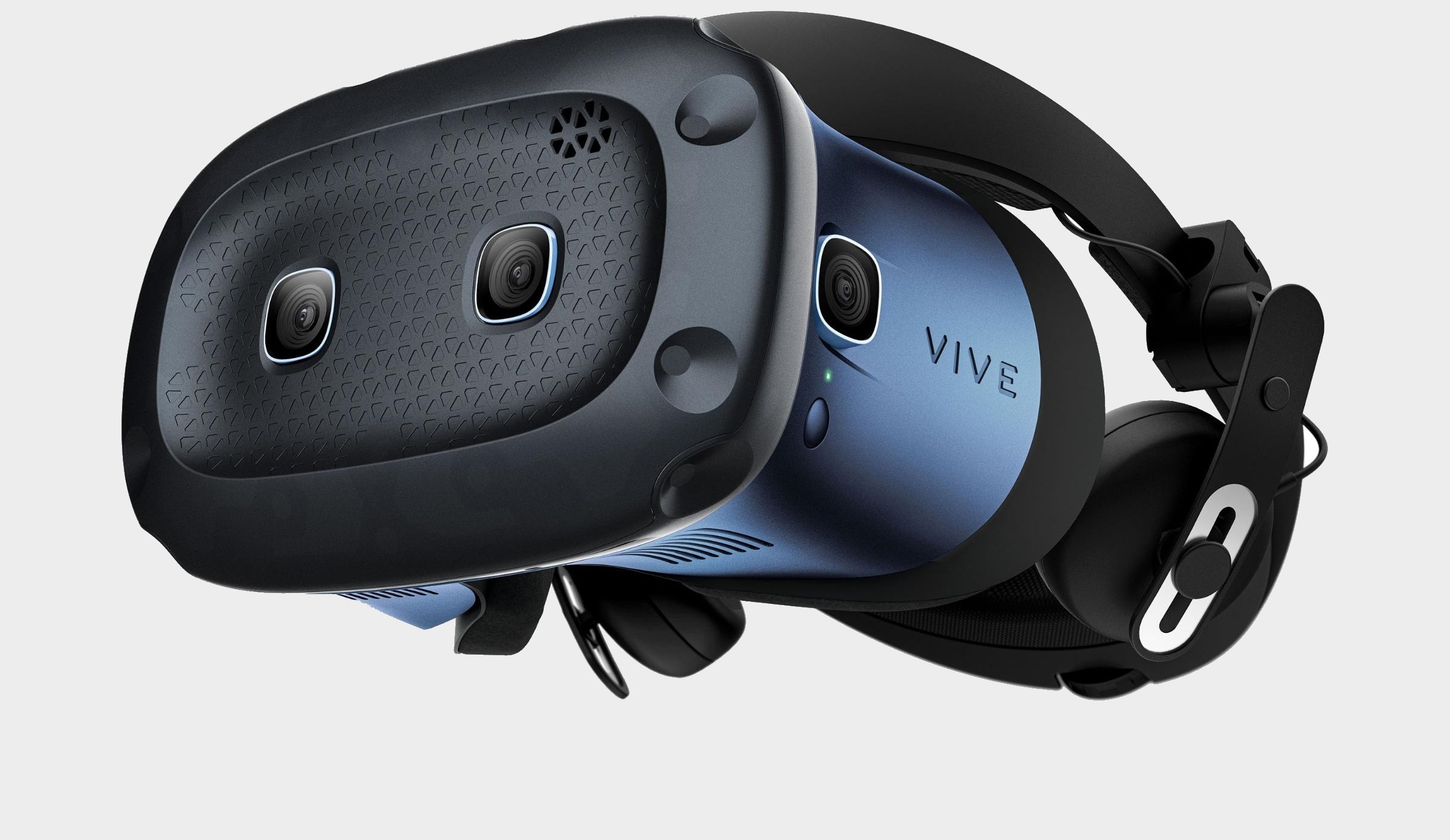Our Verdict
The HTC Vive Cosmos Elite improves accuracy at the cost of immediacy, but that price is a lot to ask for last-gen controllers and base stations.
For
- High resolutions displays
- Accurate tracking
- Half-Life: Alyx and Viveport Infinity
Against
- Very Expensive
- First-gen controllers and base stations
- Lacking innovation
PC Gamer's got your back
Tracking: Vive Base Stations 1.0
Resolution: 2880 x 1700 total (1440 x 1700 per eye)
Refresh Rate: 90 Hz
FOV: 110 degrees
Audio: Integrated speakers and microphone
Cable Length: 16 ft
Inputs: DisplayPort 1.2, USB 3.0
Weight: 2 lb
The HTC Vive Cosmos Elite is the latest tethered VR headset from the expanding Cosmos lineup. It attempts to address some of the problems with the original HTC Vive Cosmos, while maintaining the core specifications of that model, which is chiefly the dual 4.3-inch 1440 x 1700 displays running at 90 Hz. The Cosmos Elite comes bundled with the Half-Life: Alyx and 6-months of Viveport Infinity subscription, which at the very least means there are lots of things to try out with your new headset.
The Cosmos Elite is essentially the original Cosmos bundled with the first generation base stations and controllers, and a different faceplate attached to the headset. If you've already bought the Cosmos, you can upgrade it with a new faceplate for $200, although you'll need to buy your own base stations separately to use it. This modular approach also means that you add such goodies as the wireless adapter, although at $350 for that alone, this solution can get expensive quickly.
Currently the Valve Index is the headset of choice at the high-end, with the Oculus Rift S covering the slightly more affordable end of the market. The Cosmos Elite replaces the inside-out tracking of the original Cosmos, returning to base stations in order to improve accuracy. This has ramped the price up too, making for yet another expensive VR headset. Another version of the Cosmos, the Cosmos Play, is due later this year, which uses 4-camera inside-out tracking, but should be comparable in cost to the Oculus Rift S. The question right now though, is can the Cosmos Elite do enough to unseat the Valve Index?

There are a few things to set up with base station-based VR, and there's a regimented order for getting everything up and running too. It isn't just about plugging in the headset and throwing yourself into a virtual world like it is with the Oculus Rift S or the original Cosmos. Luckily the first port of call for the HTC Vive Cosmos Elite is to download an installation wizard that tells you exactly what to do, when to do it, and it highlights any problems as it goes too.
The first step is installing the base stations. These are the same two units that shipped with the original Vive, and each one needs its own power connector and also needs to be mounted in such a way so that they're not disturbed as you throw yourself about—bouncy floors are not a good idea. They have standard fittings for attaching to tripods and light stands, and inside the bundle you'll also find mounting brackets to attach them directly to your walls (complete with wall plugs and screws).
These base stations need to face each other, ideally above head height, but angled downwards so as to encompass the floor in which you've set aside for VR. You want a 6 x 6 ft space as a minimum, and depending on your home, it's surprising how hard that can be to set aside, especially as you don't want any furniture in that space—a coffee table goes from being a useful place to leave books to becoming a potential deathtrap when you can't see it.

It's worth pointing out at this point that the bundle comes with a lot of hardware, wires, and power cables. The latter of which is a little alarming when laid out in front of you. You don't need to plug absolutely everything in to use the HTC Vive Cosmos Elite, but if you're trying to recharge both controllers at the same time, that equates to a total of five power plugs, not including whatever you need for your PC.
Usually you'll only need three plugs for the Cosmos Elite—one for the headset itself, and then two for the two base stations. And you can always use spare USB ports from your PC to charge the controllers, but either way that's still a lot of wires. You'll need to use the bundled USB cables if you want to update the firmware on the base stations as well, which shouldn't happen too often, but it's still a shame that such functionality couldn't be handled over Bluetooth (in the same way that the controllers can be updated).
The main cable (the one you'll be tripping over the most), is the one that goes from your PC to the headset. As already stated, this needs power as well, but also connects to your graphics card via DisplayPort and connects to your machines via USB 3.0. It's a very long sturdy cable (at just under 16 ft), but I found it twisted easily, and it's weightiness has a tendency to disrupt the immersion. That wireless connection option, even at $350, is surprisingly tempting.
The headset itself is a tad on the heavy side at 2 lbs, but the foam is soft and the headband makes for a comfortable experience. The head mounted display (HMD) makes the whole headset front heavy, and that does put pressure on your forehead, but the headband attaches firmly, thanks to a tightening ring at the rear, so this isn't so bad. The fact that you can easily flip the display up away from your face is useful for reorienting yourself.
It does get hot though, and that's despite the tiny fan behind the faceplate being noisy in use. Luckily the inclusion of headphones offsets this a degree, especially as they can be held in place closely to your ears. And these speakers really are good in use, and are easy to clip closely to your ears, without actually touching them. Quality sound is vital to the VR experience, and these tick that box well.

The bundled controllers are comfortable, well-balanced, and intuitive enough to use, once they have been synced properly. There's a mini USB port at the bottom for charging, and their power level is clear to see in VR, although the only LED on the units is for showing when they're turned on and for the initial pairing—there wouldn't be much point in there being LEDs, as you wouldn't be able to see them with the headset on anyway.
General hand tracking works well, although a few times my hands suddenly appeared on the floor in front of me—but you will get used to such experiences and learn to waggle your way back to reattaching them. The large touchpad that naturally sits under your thumbs are responsive, as are the triggers that sit under your index fingers, which offer a good range of sensitivity, along with a satisfying click when squeezed all the way.
The menu button below the touchpad is easy to switch to, although the system button above it is more of a stretch—this is as intended though, and rarely called on. There are two buttons either side of the main grip that detect when you squeeze the controller, and these took a bit of getting used to, but overall the design is fine.
These are the controllers that shipped with the original Vive though, and while there is no question that they work, it feels like that something more is needed in this department. The Valve Index has shown that there's room for innovation when it comes to controllers, and these are holding the Cosmos Elite back.

So, what's the HTC Vive Cosmos Elite like to use? Good, but not flawless. I experienced syncing problems at times, both with the controllers and the headset. The displays are great, and the 1440 x 1700 resolution per eye meant that the screen door effect wasn't an issue, but getting both eyes in focus when flipping the display up and down can be tricky. The headphones are good as well, and really added to the immersive experience. That long main cable can be annoying though, and I wrapped it around myself a few times. The good news is that I didn't get motion sickness once, even after extended periods, although I did experience vertigo looking over ledges a few times, which I see as a positive in the immersion stakes.
I still find the general ecosystem of VR to be underwhelming. Half-Life: Alyx and a few noticeable exceptions aside, the game selection is still sketchy. There are a lot of interesting ideas out there, but there's also a lot of dross, and few actual decent games. Just looking through the hundreds of titles on Viveport sums up the situation well: VR hasn't hit the prime time yet. In some respects it's a long way off. I applaud the fact that you get Half-Life: Alyx and 6-months of Viveport Infinity with the headset though, so at least you get some fun things to play with. But overall the state of VR does bring into question any serious investment into it.
Should you buy the HTC Vive Cosmos Elite? It's a tricky one to recommend for the money, but ultimately comes down to what your expectations are. The launch price of $899 doesn't match up comfortably with the first-generation controllers and base stations—even if they do work fine. The headset itself is good, and there's a lot of attention to the user experience here as far as setup is concerned. Still, for only $100 more, you can get the Valve Index, and that still has the edge for now.
The HTC Vive Cosmos Elite improves accuracy at the cost of immediacy, but that price is a lot to ask for last-gen controllers and base stations.
Alan has been writing about PC tech since before 3D graphics cards existed, and still vividly recalls having to fight with MS-DOS just to get games to load. He fondly remembers the killer combo of a Matrox Millenium and 3dfx Voodoo, and seeing Lara Croft in 3D for the first time. He's very glad hardware has advanced as much as it has though, and is particularly happy when putting the latest M.2 NVMe SSDs, AMD processors, and laptops through their paces. He has a long-lasting Magic: The Gathering obsession but limits this to MTG Arena these days.



